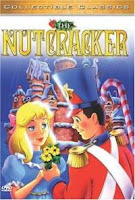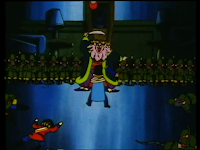There once was a Belgian man named Georges Prosper Remi who, under the pen name of Hergé, wrote and drew comic adventures of a boy reporter named Tintin and his dog Snowy. The series ran for many years and was collected into graphic novel-style "albums." (The actual "graphic novel" idea didn't come around until years later, so these were the forerunners of it.) These albums have since been translated into many languages around the world and sold well.
Over the years, Tintin was adapted for film as a stop-motion animated film, two live action films, two different animated television shows, and some animated films.
In the early 1980s, Steven Spielberg was given the blessing to make a Tintin film by Hergé himself. Now, almost 30 years later, the film has finally arrived.
The Adventures of Tintin is animated with motion capture. The characters are CG, looking like actual people, but with exaggerated features based on their original comic appearances.
The story is based on three of Hergé's albums:
The Crab With The Golden Claws,
The Secret of the Unicorn, and
Red Rackham's Treasure. The first draft of the script was by current
Doctor Who showrunner Steven Moffat, and it was later revised by Edgar Wright and Joe Cornish. (Moffat dropped out because he was offered
Who.)
The music is by John Williams, and while it helps the film flow well, the score isn't very memorable.
The story finds Tintin buying a model ship in an open-air market. It's based on the ship
The Unicorn, and Tintin is surprised when two men offer to buy it from him. Taking it home, his dog, Snowy, and a wandering cat accidentally damage the ship.
Tintin goes to research
The Unicorn and discovers it was a cargo ship captained by a Sir Francis Haddock, and it was said to have had a secret cargo. It was boarded by pirates and sunk one night, the only survivor being Sir Francis.
Tintin returns home to find his ship missing. He goes after one of the men who tried to buy it from him, and finds a model of
The Unicorn in Mr. Sakharine's possession, but it's not broken. Returning home again, Tintin's home has been ransacked. He goes downstairs where the other man who tried to buy the ship tries to warn him about something but is shot before he can do anything.
Enter detectives Thompson and Thomson, who look almost identical (Thompson has a flared moustache). The bumbling detectives are on the case of a pickpocket who manages to steal Tintin's wallet which contains a scroll that fell out of
The Unicorn model when it broke and was unnoticed by the thieves. Going back home, Tintin is suddenly kidnapped and taken aboard
The Karaboudjan, a ship Sakharine has chartered to go to the port of Bagghar in Morocco.
Escaping his prison (with help from stowaway Snowy), Tintin meets the drunk captain, Archibald Haddock. He reveals he is the last of the Haddock line, descended from Sir Francis, who he knows he doesn't live up to.
Now, all Tintin, Snowy, and Captain Haddock have to do is figure out what Sakharine's scheme is, foil it, and maybe recover the reputation of the Haddocks. And what is the secret of
The Unicorn?
The plot is action-filled, and definitely deserves the word
Adventures in the title. It's quite an exhilarating film from start to finish. There may, however, be too much action in the film. I can see this criticism. Suddenly, Tintin's life is in danger because he purchased a model ship. It is a bit of a stretch, even if you're familiar with the source material. And when it feels like the film is going to give you a break, we're suddenly given the story of Sir Francis and the last night on
The Unicorn. The action isn't necessarily bad, but a solid break or two from it would have been nice. Hergé's original stories are not that action filled and are full of many silly outcomes from it, some of which are retained in the film.
The plot is a loose adaptation. The opening is from
The Secret of the Unicorn, and then it goes to
The Crab With The Golden Claws, and at the end, there's a touch of
Red Rackham's Treasure. There's also some original plot points not from Hergé's work at all. The plot tells a nice story, but some may wonder just how strong it is. Moffat himself has proved himself to be a master storyteller on
Doctor Who, but as his draft was just the first, I begin to suspect Cornish and Wright of tampering a bit too much. Perhaps it would have been better if Spielberg, Second Unit Director Peter Jackson, and maybe Jackson's wife Fran Walsh had finished the script themselves. (They were two of the writers for
The Lord of the Rings film trilogy, come on!)
One of the best developments in the plot is Captain Haddock's character. He begins as an oafish, layabout drunk who tells himself he'll never amount to anything, but Tintin's influence helps him actually get back on his feet and get his life back on track.
The characterizations were all spot-on, considering the film is aimed at today's audience (the original Tintin stories began in 1929, times have changed). The only one not like his character from Hergé's comics is the villainous Mr. Sakharine. In the original stories, Mr. Sakharine was a ship collector who already had one of
The Unicorn models. Later, Tintin and Captain Haddock find him knocked unconscious and his model of
The Unicorn broken, and that's all there is to him. The Bird brothers were the villains there, but here, I suppose, they felt a single villain would be better to handle, and instead of using two, they just wholly reinvented a relatively minor character. Bianca Castafiore, it should also be noted, does not sing her signature song from the comics, but considering the plot, it is possible she was asked to sing a different piece.
The animation, I have seen people complain about. I didn't spot anything really inconsistent or unnatural as some people have complained of. People have also complained about the "uncanny valley," in which a character looks so human that their imperfections make them creepy. This is mostly noted in the eyes which don't light up correctly, or the pupils fail to dilate. To me, because the characters were still stylized (the noses), it didn't bother me. In fact, I want a Tintin action figure. However, this form of animation has yet to master completely realistic eyes.
The film was also released in 3D, which I saw it in. The 3D doesn't pop out of the screen, meaning it's not distracting, and adds a nice layer of depth to the film. However, I felt like I still could have enjoyed the film just as well in 2D. I would have done so, but there were fewer showings of the 2D version.
So,
The Adventures of Tintin is a great film that brings Hergé's beloved characters to life. The film is worth seeing, though it is not absolutely perfect. Next time, don't get comedians to finish the script, pace it a bit better, and work some more on getting the animation right. And as a sequel has been greenlit already, we might very well hope that they improve in those areas.

























































